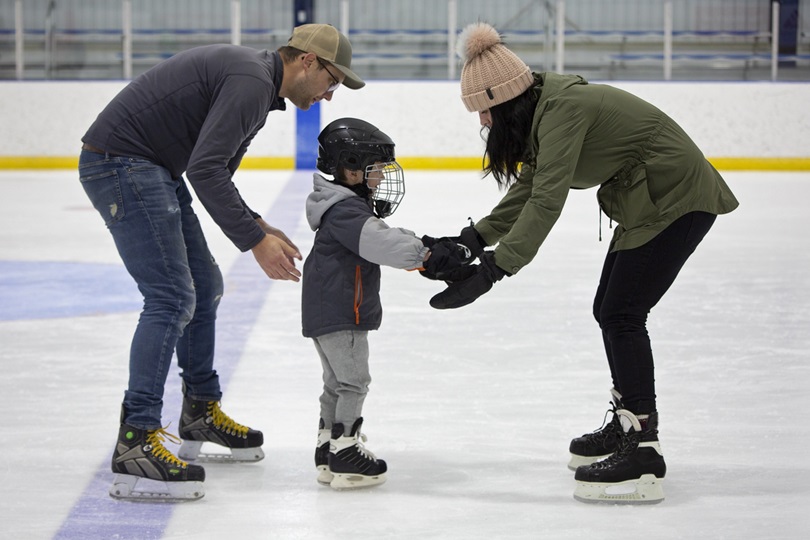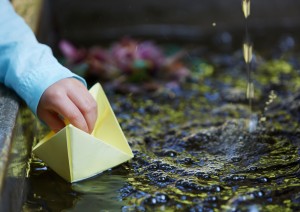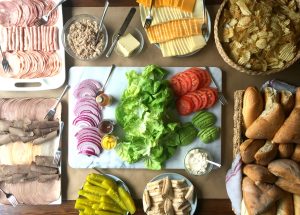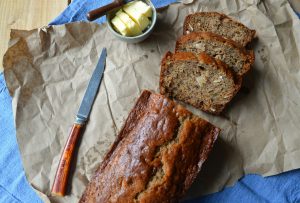Teaching Kids to Skate: Tips, Tricks, and Fun Ideas

Skating is a quintessential Canadian winter activity. But, for many parents, teaching kids to skate can feel daunting—especially if they don’t know how to skate themselves. Maybe your child dreams of gliding gracefully across the ice or maybe they’d be happy just staying upright? Whatever ice fantasies they may or may not have, learning to skate can be a fun and rewarding experience that fosters confidence, resilience, and a lifelong love of winter sports. Here’s how to make teaching kids to skate enjoyable for everyone, parents included!
Tips and Ideas for Teaching Kids to Skate
1. Start with the Basics
- Choose the Right Skates: Skates should fit snugly without pinching. Look for beginner-friendly skates with good ankle support and get them sharpened regularly for better control. Don’t forget to check your own skates if you’re planning to join in!
- Protective Gear is Key: A CSA-certified hockey helmet is non-negotiable for kids learning to skate, and it’s a good idea for beginner adults too. Hockey gloves, knee/shin pads, and wrist guards can also provide extra protection for new skaters.
- Dress for Success: Layer kids in warm but flexible clothing like thermal leggings, waterproof pants or snowpants, and light jackets that allow for movement. For parents, skip bulky coats that restrict arm movement.
2. Pick the Right Location
- Begin Indoors or on Smooth Outdoor Rinks: Start on well-maintained ice with fewer distractions. Many indoor arenas have designated beginner sessions that are less crowded and more relaxed.
- Community Rinks and Programs: Look for free or affordable community rinks that provide skating aids, beginner-friendly lessons, or special family skate times.
- Explore Nature Trails: Once everyone gains confidence, try outdoor skating trails for a magical winter experience.
- Here are some great places to skate with the family in Toronto, Ottawa, Calgary, and Vancouver
3. Keep It Fun and Playful
- Make it a Game: Games like “Red Light, Green Light,” “Follow the Leader,” or pretending to be animals (sliding penguins, stomping elephants) keep kids engaged.
- Celebrate Small Wins: Every step, slide, or even fall is progress! Cheer them on and keep the focus on fun.
- Short Sessions, Big Wins: Young kids tire quickly, especially in the cold. Sessions of 20-30 minutes is plenty good for beginners. Be sure to end on a positive note before they get frustrated.
4. Teach Technique Gradually
- Falling and Getting Up: Teach kids to fall safely by landing on their side with bent knees. Falling is a part of skating! Teach them how to get up by rolling to their hands and knees before pushing up, one foot at a time.
- The “March and Glide” Method: Start with marching steps on the ice, then progress to small glides. Encourage bent knees and leaning slightly forward to find balance.
- Use Visual Cues: Draw shapes on the ice with chalk or cones to create “paths” for kids to follow.
When Parents Need to Learn How to Skate Too
For parents who never learned to skate or haven’t been on the ice in years, this is the perfect opportunity to join your kids in learning something new. Here’s how to get started…
Tips for Parents Learning to Skate:
Embrace the Beginner Mindset
- It’s Never Too Late: Many adults feel self-conscious about learning to skate. Remember—it’s just like any new skill. Your kids will admire your effort, and learning together can be a fun bonding experience.
- Take Beginner Classes: Look for adult beginner skating lessons at community centres or outdoor rinks. Structured lessons with a coach can help build confidence and technique.
- Invest in Your Comfort: A good pair of skates is essential. Your 20-year-old skates might need replacing. Rental skates are fine for beginners, but having your own pair that fits well makes a big difference.
Master the Basics
- Focus on Balance: Practice standing still on the ice, shifting your weight, and taking small steps before attempting a glide.
- Learn to Fall Safely: Remember! Falling is a part of skating! Practice falling and getting up properly to reduce the fear.
- Build Strength and Confidence: Simple exercises like squats or balancing on one leg off the ice can improve strength and balance.
Make It Fun for You
- Celebrate Your Progress: Be kind to yourself and celebrate small wins, just as you would for your kids.
- Pair with Family Time: Learn together or practice during family skate sessions so it feels less like work and more like play.
Skating Aids: Helpful or Hindering?
For Kids: Frames or chairs can help younger kids feel stable, but encourage them to let go gradually and rely on their balance.
For Adults: If you’re learning, don’t shy away from using the rink boards for support or trying a skating aid yourself until you feel more confident. Watch your back. Those things are usually meant for those under 4ft tall.
Create New Family Traditions
- Plan Regular Skate Days: Turn skating into a weekly family outing. Explore different rinks or trails to keep it exciting.
- Bring Snacks and Warm Drinks: Hot chocolate and cookies are great incentives for kids to take a break and refuel.
- Capture the Memories: Take photos or videos to celebrate milestones—your child’s first glide or your first successful lap around the rink!
When to Enroll in Lessons
If you or your kids are struggling with confidence or technique, consider signing up for formal skating lessons. Many programs cater to beginners of all ages, offering expert guidance in a supportive environment.
Teaching kids to skate is a rewarding experience that can build their confidence and create cherished family memories. Whether you’re a seasoned skater or just starting out yourself, the key is to keep it light, fun, and pressure-free. Lace up, hit the ice, and embrace the joy of learning together!














